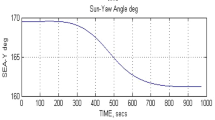Abstract
The satellite for earth observation (Bhaskara) launched on 7 June 1979 has two TV cameras and a passive microwave radiometer for earth resources survey and meteorological studies respectively. As it had to be a minimally modified version of the earlier spin-stabilised satelliteAryabhata, it is configured as a spin-stabilised satellite, with a spin rate of between 6 to 11 rev/min and a spin axis perpendicular to the orbital plane within 3°. The cold gas system ofAryabhata was modified to provide a low and controlled thrust for spin-up and spin-axis orientation operations. Two horizon-crossing sensors are used for automatic spin-axis control and attitude determination on ground. This paper presents a report on the system evolution, design, simulation and on-orbit performance ofBhaskara.
Similar content being viewed by others
Abbreviations
- A:
-
wetted area of the damper
- a:
-
semi-major axis
- c d :
-
distance of the damper plane from the spacecraft co
- C f :
-
coefficient of friction between the damper fluid and wall
- d:
-
diameter of the damper tube
- e:
-
eccentricity
- g:
-
fill angle of the damper
- I X,I y :
-
moment of inertia of the satellite aboutx, y (body fixed co-ordinates) respectively
- I z :
-
moment of inertia about spin axisi.e. z-axis
- i a :
-
inclination of the orbit
- M:
-
earth’s dipole moment (- 8.06 x 1016 WM3)
- R:
-
radius of the damper
- r:
-
radius of the earth
- t:
-
time
- Ωa :
-
orbit cross-over angle from vernal equinox
- v:
-
coning angle
- v f :
-
final coning angle after some damping timet d
- vi :
-
initial coning angle
- vres :
-
residual coning angle
- ξ:
-
angle between the geomagnetic dipole moment and geometric north
- ρ:
-
density of the fluid
- ω z :
-
spin rate of the spacecraft
References
Goel P S, Padmanabhan P, Murugesan S, Kameswara Rao C & Rao P S N 1980IEEE Trans. Audio Electroacoust.
ISRO 1977a Design report on attude control system for SEO, Doc. No. SEO-ISSP-11-76-07-5-011 Rev. 01, Control Systems Section, Satellite Centre.
ISRO 1977b ‘Spin-axis orientation channel/data command computation for satellite for earth observation (SEO)’, Doc. No. SEO-ISAC-31-77-07-5-010, Control Systems Section, Satellite Centre.
SRO 1977c Design Report on pressure regulator (SEO Control Systems) Doc. No. SEO-ISAC-31-77-12-5-05, Control Systems Section, Satellite Centre
ISRO 1977d Design report on solenoid valve, (SEO Control Systems) Doc. No. SEO-ISAC-31-77-12-5-009, Control Systems Section, Satellite Centre
ISRO 1978 Document on nozzle test facility, Doc. No. ISAC-31-78-03-5-003, Control Systems Section, Satellite Centre
ISRO 1980 Acceptance test procedures for pneumatic components, (SEO-II Control System) Doc. No. SEO-II-ISAC-31-80-07-3-008, Control Systems Section, Satellite Centre
Renard M L 1953 Attitude perturbation and magnetic attitude control of a spin stabilised satellite, ESRO TR-1 (ESTEC)
Rogers E E 1953 A mathematical model for predicting the damping time of a mercury damper, US Naval Ordinance Test Report No. 10.
Author information
Authors and Affiliations
Rights and permissions
About this article
Cite this article
Goel, P.S., Nagabushanam, S., Murugesan, S. et al. The attitude control system of the satellite for earth observation ‘ Bhaskara ’. Proc. Indian Acad. Sci. (Engg. Sci.) 5, 1–27 (1982). https://doi.org/10.1007/BF02843100
Received:
Revised:
Issue Date:
DOI: https://doi.org/10.1007/BF02843100




